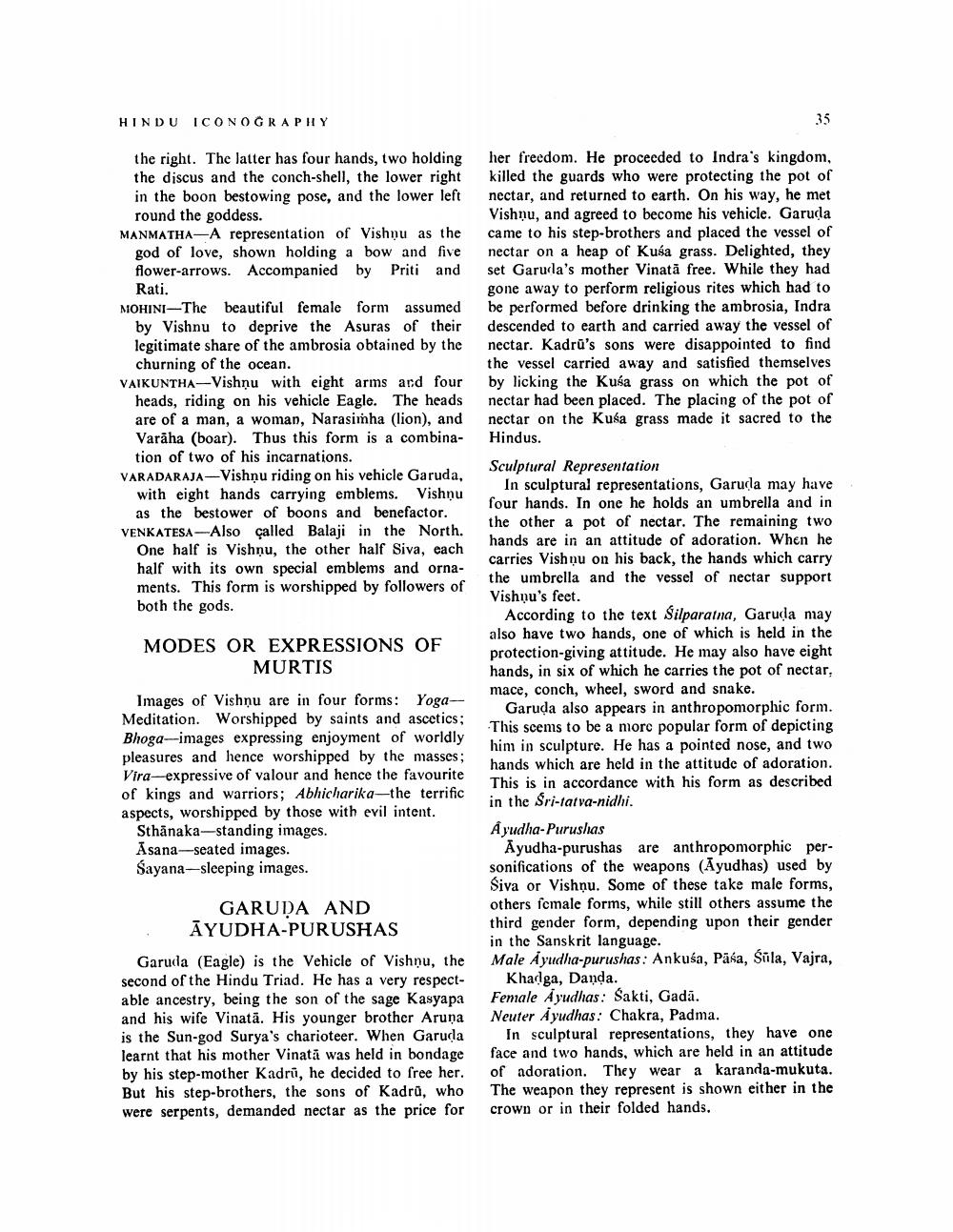________________
HINDU ICONOGRAPHY
35
the right. The latter has four hands, two holding the discus and the conch-shell, the lower right in the boon bestowing pose, and the lower left
round the goddess. MANMATHA-A representation of Vishnu as the
god of love, shown holding a bow and five flower-arrows. Accompanied by Priti and
Rati. MOHINI -The beautiful female form assumed
by Vishnu to deprive the Asuras of their legitimate share of the ambrosia obtained by the
churning of the ocean. VAIKUNTHA-Vishnu with eight arms and four
heads, riding on his vehicle Eagle. The heads are of a man, a woman, Narasimha (lion), and Varaha (boar). Thus this form is a combina-
tion of two of his incarnations. VARADARAJA-Vishnu riding on his vehicle Garuda,
with eight hands carrying emblems. Vishnu
as the bestower of boons and benefactor. VENKATESA-Also called Balaji in the North.
One half is Vishnu, the other half Siva, each half with its own special emblems and ornaments. This form is worshipped by followers of both the gods.
her freedom. He proceeded to Indra's kingdom, killed the guards who were protecting the pot of nectar, and returned to earth. On his way, he met Vishnu, and agreed to become his vehicle. Garuda came to his step-brothers and placed the vessel of nectar on a heap of Kuša grass. Delighted, they set Garula's mother Vinată free. While they had gone away to perform religious rites which had to be performed before drinking the ambrosia, Indra descended to earth and carried away the vessel of nectar. Kadrū's sons were disappointed to find the vessel carried away and satisfied themselves by licking the Kusa grass on which the pot of nectar had been placed. The placing of the pot of nectar on the Kusa grass made it sacred to the Hindus. Sculptural Representation
In sculptural representations, Garudla may have four hands. In one he holds an umbrella and in the other a pot of nectar. The remaining two hands are in an attitude of adoration. When he carries Vishnu on his back, the hands which carry the umbrella and the vessel of nectar support Vishnu's feet.
According to the text Silparatna, Garuda may also have two hands, one of which is held in the protection-giving attitude. He may also have eight hands, in six of which he carries the pot of nectar, mace, conch, wheel, sword and snake.
Garuda also appears in anthropomorphic form. This scems to be a more popular form of depicting him in sculpture. He has a pointed nose, and two hands which are held in the attitude of adoration. This is in accordance with his form as described in the Sri-tatva-nidhi. Ayudha-Purushas
Ayudha-purushas are anthropomorphic personifications of the weapons (Ayudhas) used by Siva or Vishnu. Some of these take male forms, others female forms, while still others assume the third gender form, depending upon their gender in the Sanskrit language. Male , yudha-purushas: Ankusa, Paka, Sūla, Vajra,
Kharga, Danda. Female A yudhas: Sakti, Gadā. Neuter A yudhas: Chakra, Padma.
In sculptural representations, they have one face and two hands, which are held in an attitude of adoration. They wear a karanda-mukuta. The weapon they represent is shown either in the crown or in their folded hands.
MODES OR EXPRESSIONS OF
MURTIS
Images of Vishnu are in four forms: Yoga-- Meditation. Worshipped by saints and ascetics; Bhoga---images expressing enjoyment of worldly pleasures and hence worshipped by the masses; Vira-expressive of valour and hence the favourite of kings and warriors; Abhicharika--the terrific aspects, worshipped by those with evil intent.
Sthānaka-standing images. Asana-seated images. Sayana-sleeping images.
GARUDA AND
AYUDHA-PURUSHAS Garuda (Eagle) is the Vehicle of Vishnu, the second of the Hindu Triad. He has a very respectable ancestry, being the son of the sage Kasyapa and his wife Vinată. His younger brother Aruna is the Sun-god Surya's charioteer. When Garuda learnt that his mother Vinată was held in bondage by his step-mother Kadri, he decided to free her. But his step-brothers, the sons of Kadrů, who were serpents, demanded nectar as the price for




